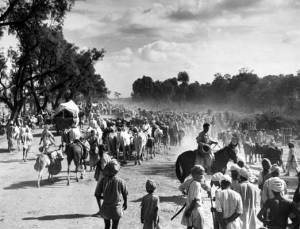Mohajir Qaumi Movement or Muttahida Qaumi Movement (MQM) claims to be a representative party of Mohajirs, or refugees, who moved to Pakistan after 1947. According to MQM definitiojn, Mohajirs are those refugees who speak Urdu as their mother tongue. They refuse to accept refugees of other ethnicities as Mohajirs. They insist on their cultural superiority and that their forefathers alone were the makers of Pakistan.
MQM, is a political party of Pakistan founded on ethnic lines and known for violence and hate-mongering. In an effort to claim political mileage, it is driving further wedge between various ethnic groups living in the country. A similar claim led to break-up of Pakistan in 1971 when the Urdu-speaking migrants to East Pakistan tried to divide the society on the basis of ethnicity and the so-called superiority of their culture and language. This is being tried in Pakistan of today by an ethnic party who claim special treatment because their ancestors made Pakistan. This is being done out of sheer desperation because a new party, PTI, has emerged to challenge the grip of hate-mongers in the port city of Karachi.
This claim has brought the debate about creation of Pakistan into a sharp focus again with some critical questions; who made Pakistan and who gave sacrifices for its establishment?
It will be in order to bring some historical facts to attention of the readers of this page.
Pakistan came into being on August 15, 1947 to become homeland to millions of Muslims living in various parts of undivided India. Geographically, it comprised of the areas home to Muslims in majority. Its separation from the Hindu majority was aimed at sparing the Muslims from hegemonic atrocities and exploitation of Muslims at the hands of extremists Hindus in majority. The vision for Pakistan was presented by poet-philosopher, Iqbal from Sialkot in Punjab. He pursued to realize his dream of a separate homeland for Muslims in the Muslim-majority areas. The political party of Muslims deliberated on it and finally adopted Pakistan Resolution in 1940 in Lahore, the cultural capital of Punjab. The resolution was tabled by Lion of Bengal, Maulvi Fazle-Haq.
The elections of 1946 were a turning point for creation of Pakistan. The Sindh Assembly adopted a resolution to become a part of Pakistan and there was referendum in NWFP (KPK of today) and Balochistan which overwhelmingly supported Pakistan. Punjab and East Bengal had already voted in support of Pakistan. All India Muslim League, the political party which fought the battle to make Pakistan was founded in 1906 in Dhakka and its first president was Nawab Salimullah. Jinnah, the Father of the Nation who actually founded Pakistan was a Gujarati whose father had settled in Karachi. Pakistan’s first prime minister, Liaquat Ali Khan was born in Karnal (now in Haryana).
The community which bore the brunt of creation of Pakistan was Punjabi Muslims who were killed in hundreds of thousands while they were on their way to their new homeland. The Sikh violence was unleashed mostly in Punjab targeting Punjabi Muslims. According to historical data, a huge population exchange occurred between the two newly formed states in the aftermath of partition. About 14.5 million people crossed the borders, including 8,226,000 Muslims who came to Pakistan from India. About 5.5 million settled in Punjab and around 1.5 million settled in Sindh.
Most of those migrants who settled in Punjab, Pakistan came from the neighboring Indian regions of Punjab, Haryana and Himachal Pradesh while others were from Jammu and Kashmir and Rajasthan. On the other hand, most of those migrants who arrived in Sindh were primarily of Urdu-speaking background (termed the Muhajir people) and came from the northern and central urban centers of India, such as Uttar Pradesh, Bihar, and Madhya Pradesh. However a limited number of Muhajirs also arrived by air and on ships. Later in 1950s, the majority of Urdu speaking refugees who migrated after the independence were settled in the port city of Karachi in southern Sindh and in the metropolitan cities of Hyderabad, Sukkur, Nawabshah and Mirpurkhas. In addition, some Urdu-speakers settled in the cities of Punjab, mainly in Lahore, Multan, Bahawalpur and Rawalpindi. The number of migrants in Sindh was placed at over 540,000 of whom two-third were urban.
The Urdu-speaking minority which had the advantage of being better educated entrenched themselves in civil services and media. They worked hard to strengthen the perception that they alone were makers of Pakistan insulting the collective mandate of Punjab, East Bengal, Sindh, NWFP and Balochistan and the sacrifices of millions who lost their lives and belongings in Punjab. Their claim that they are descendants of the makers of Pakistan is only laughable in the face of historical facts.
In late 70s, Pakistan Television, the only channel of those days, serialized a drama Manzil, based on a novel Tahira written by Inyatullah. The story of the novel revolved around Punjabi families who struggled for creation of Pakistan and suffered hugely. Munno Bhai, who wrote the script disassociated himself from the production because he was under pressure not to highlight the sacrifices of Punjabis. The story was distorted by the newly hired writer. So much was the influence of Urdu-speaking media people.
While Urdu-speaking Muslims did play their role and offered supreme sacrifices, it would be a travesty of history to claim immunity from law on hate mongering and terrorism in the name of noble and great Urdu-speaking leaders of Pakistan Movement. It is an insult to their greatness.
Pakistan Express: MQM and the Makers of Pakistan; Myth and Reality
